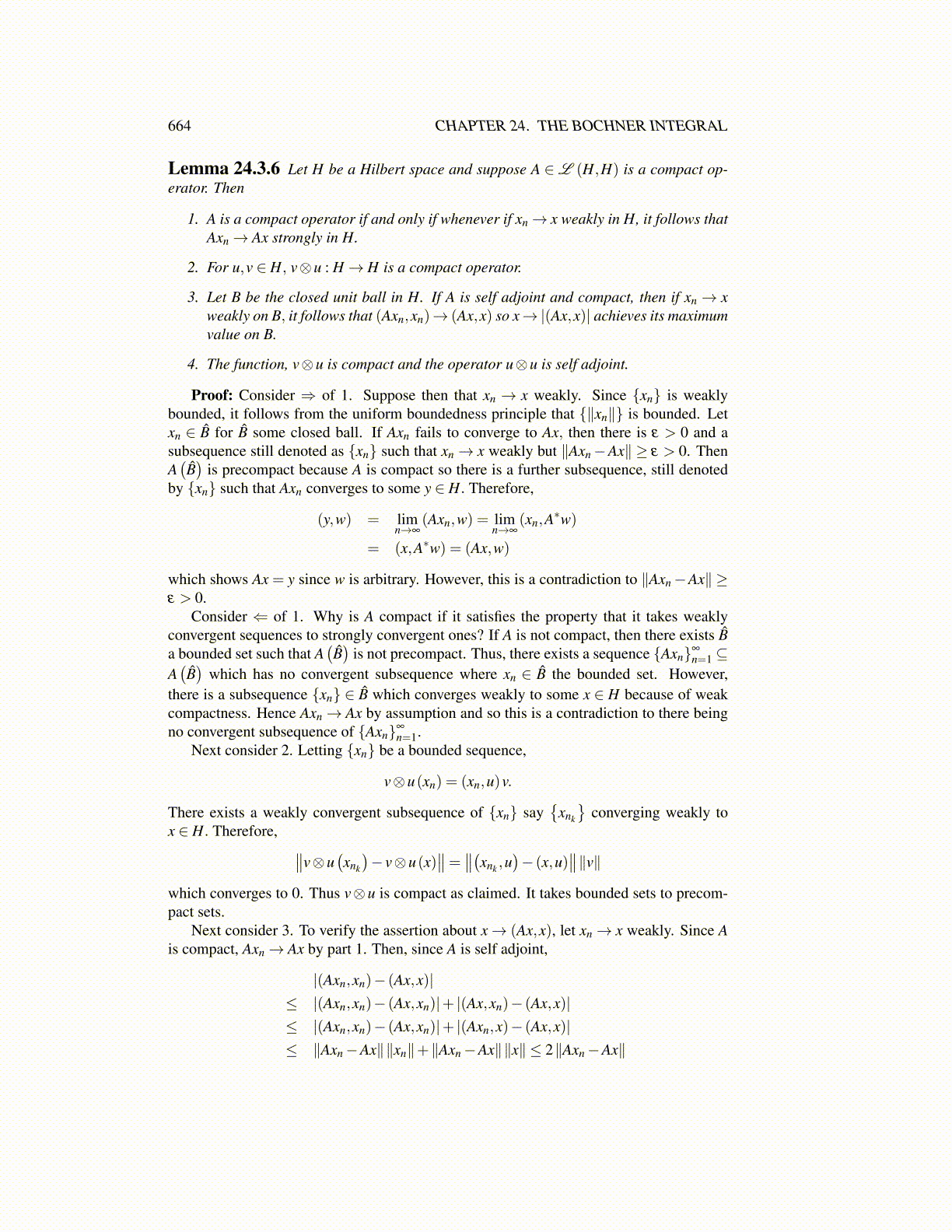
664 CHAPTER 24. THE BOCHNER INTEGRAL
Lemma 24.3.6 Let H be a Hilbert space and suppose A ∈L (H,H) is a compact op-erator. Then
1. A is a compact operator if and only if whenever if xn→ x weakly in H, it follows thatAxn→ Ax strongly in H.
2. For u,v ∈ H, v⊗u : H→ H is a compact operator.
3. Let B be the closed unit ball in H. If A is self adjoint and compact, then if xn → xweakly on B, it follows that (Axn,xn)→ (Ax,x) so x→|(Ax,x)| achieves its maximumvalue on B.
4. The function, v⊗u is compact and the operator u⊗u is self adjoint.
Proof: Consider ⇒ of 1. Suppose then that xn → x weakly. Since {xn} is weaklybounded, it follows from the uniform boundedness principle that {∥xn∥} is bounded. Letxn ∈ B̂ for B̂ some closed ball. If Axn fails to converge to Ax, then there is ε > 0 and asubsequence still denoted as {xn} such that xn→ x weakly but ∥Axn−Ax∥ ≥ ε > 0. ThenA(B̂)
is precompact because A is compact so there is a further subsequence, still denotedby {xn} such that Axn converges to some y ∈ H. Therefore,
(y,w) = limn→∞
(Axn,w) = limn→∞
(xn,A∗w)
= (x,A∗w) = (Ax,w)
which shows Ax = y since w is arbitrary. However, this is a contradiction to ∥Axn−Ax∥ ≥ε > 0.
Consider ⇐ of 1. Why is A compact if it satisfies the property that it takes weaklyconvergent sequences to strongly convergent ones? If A is not compact, then there exists B̂a bounded set such that A
(B̂)
is not precompact. Thus, there exists a sequence {Axn}∞
n=1 ⊆A(B̂)
which has no convergent subsequence where xn ∈ B̂ the bounded set. However,there is a subsequence {xn} ∈ B̂ which converges weakly to some x ∈ H because of weakcompactness. Hence Axn→ Ax by assumption and so this is a contradiction to there beingno convergent subsequence of {Axn}∞
n=1.Next consider 2. Letting {xn} be a bounded sequence,
v⊗u(xn) = (xn,u)v.
There exists a weakly convergent subsequence of {xn} say{
xnk
}converging weakly to
x ∈ H. Therefore, ∥∥v⊗u(xnk
)− v⊗u(x)
∥∥= ∥∥(xnk ,u)− (x,u)
∥∥∥v∥which converges to 0. Thus v⊗u is compact as claimed. It takes bounded sets to precom-pact sets.
Next consider 3. To verify the assertion about x→ (Ax,x), let xn→ x weakly. Since Ais compact, Axn→ Ax by part 1. Then, since A is self adjoint,
|(Axn,xn)− (Ax,x)|≤ |(Axn,xn)− (Ax,xn)|+ |(Ax,xn)− (Ax,x)|≤ |(Axn,xn)− (Ax,xn)|+ |(Axn,x)− (Ax,x)|≤ ∥Axn−Ax∥∥xn∥+∥Axn−Ax∥∥x∥ ≤ 2∥Axn−Ax∥